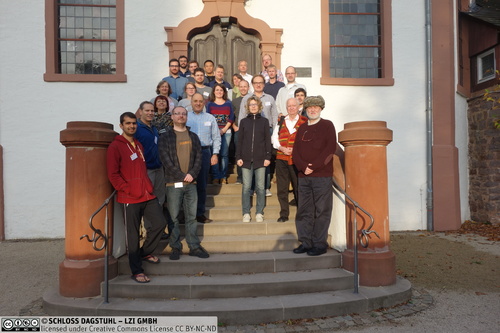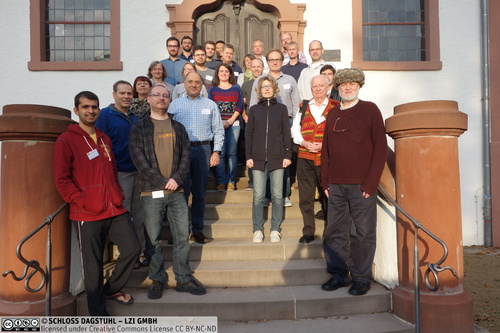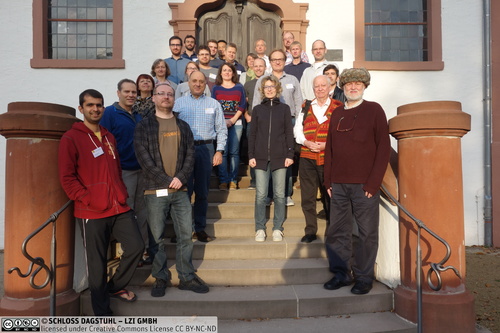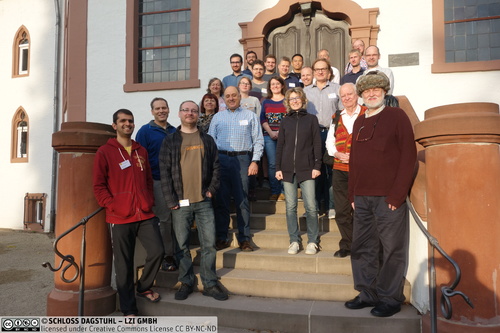Dagstuhl Seminar 18422
Shape Analysis: Euclidean, Discrete and Algebraic Geometric Methods
( Oct 14 – Oct 19, 2018 )
Permalink
Organizers
- Michael Breuß (BTU Cottbus, DE)
- Alfred M. Bruckstein (Technion - Haifa, IL)
- Christer Oscar Kiselman (Uppsala University, SE)
- Petros Maragos (National Technical University of Athens, GR)
Contact
- Andreas Dolzmann (for scientific matters)
- Susanne Bach-Bernhard (for administrative matters)
In computer vision and image analysis, 3-D shapes have traditionally been studied by analyzing a sparse set of marker positions on 3-D shapes. Within the last years, there have been many technological developments that expand the potential of methods dealing with 3-D digital shape representations. As examples let us mention the use of laser-range scanners, or depth cameras like the Kinect sensor. However, not only the acquisition of digitized 3-D shapes has become much easier, there are also interesting trends to make broader use of 3-D information. Developments in 3-D printing enable novel emerging technologies, whereas holographic displays are predicted to enter the mass market in a few years. The key to all the mentioned technologies is the proper use and manipulation of 3-D shapes.
The purpose of this seminar is to address upcoming challenges in the scientific and industrial use of shape analysis methods by combining recent developments in that field with the latest tools from different areas of geometry as well as modern algorithmic and numerical concepts.
Classic shape analysis tools from differential geometry have a fresh influence in the field, often powered by modern methods from optimization and numerical computing. At the same time, discrete geometric methods and related techniques such as from mathematical morphology have evolved significantly. Moreover, techniques like deep learning may also have a significant influence in the development of corresponding methods and tools. New developments from tropical geometry have a high potential for use in shape analysis. With the advent of novel potential applications and new possibilities to describe geometric shape properties, we conjecture that the proposed seminar may inspire important lines of shape analysis research.
The topics we will address in our seminar are in accordance with the sketched challenges and developments that can be useful for shape analysis. Especially we aim to discuss the possibilities of combining emerging fields like tropical geometry with more classical techniques as for instance from mathematical morphology. We also plan to investigate possibilities of applying machine learning methods in this context and discuss recent advances from more classical fields like differential geometry and partial differential equations that can be useful for setting up and understanding shape analysis methods in all of these approaches.
 Michael Breuß, Alfred M. Bruckstein, Christer Oscar Kiselman, and Petros Maragos
Michael Breuß, Alfred M. Bruckstein, Christer Oscar Kiselman, and Petros Maragos
Dagstuhl Seminar 18422 Shape Analysis: Euclidean, Discrete and Algebraic Geometric Methods took place October 14–19, 2018. 26 researchers from North America and Europe discussed state-of-the-art, current challenges, and promising future research directions in the areas of 2-D and 3-D shape analysis from a cross-disciplinary point of view. Participants included international experts from the fields of continuous-scale shape analysis, discrete shape analysis, tropical geometry and numerical computing. The seminar consisted of an opening and getting to know session and 26 scientific presentation sessions. Furthermore, there was time for extensive discussions both between the talks and in the evenings.
The topics in our seminar addressed the sketched challenges and developments that will be useful for shape analysis. Especially we aimed to discuss the possibilities of combining fields like tropical geometry with more classical techniques as for instance from mathematical morphology. We discussed possibilities of applying machine learning methods in this context and considered recent advances from more classical fields like differential geometry and partial differential equations that can be useful for setting up and understanding shape analysis methods in all of these approaches.
The purpose of this seminar was to address these challenges with the latest tools related to geometric, algorithmic and numerical concepts. To do so, we brought together researchers working on shape analysis topics from different perspectives. The purpose in bringing together researchers from those different communities sharing substantial interest in shape analysis was to explore the benefits of a cross-disciplinary point of view.
Promising new ways to combine the latest techniques from these different fields were identified during in-depth discussions in small groups. Some especially promising research directions in the areas of deep learning, mathematical morphology, shape from shading, modelling deformable shapes, and tropical geometry were discussed in small groups between the talks and in the evenings.
 Michael Breuß, Alfred M. Bruckstein, Christer Oscar Kiselman, and Petros Maragos
Michael Breuß, Alfred M. Bruckstein, Christer Oscar Kiselman, and Petros Maragos
- Marianne Akian (INRIA Saclay - Palaiseau, FR) [dblp]
- Jesús Angulo (Ecole des Mines de Paris, FR) [dblp]
- Péter Balázs (University of Szeged, HU) [dblp]
- Michael Breuß (BTU Cottbus, DE) [dblp]
- Alfred M. Bruckstein (Technion - Haifa, IL) [dblp]
- Sara Brunetti (University of Siena, IT) [dblp]
- Vasileios Charisopoulos (Cornell University, US) [dblp]
- Robert Dachsel (BTU Cottbus, DE) [dblp]
- Leila De Floriani (University of Maryland - College Park, US) [dblp]
- Panagiotis Filntisis (National Technical University of Athens, GR) [dblp]
- Federico Iuricich (Clemson University, US) [dblp]
- Tao Ju (Washington University - St. Louis, US) [dblp]
- Bert Jüttler (Johannes Kepler Universität Linz, AT) [dblp]
- Joe Kileel (Princeton University, US) [dblp]
- Ron Kimmel (Technion - Haifa, IL) [dblp]
- Christer Oscar Kiselman (Uppsala University, SE)
- Zorah Lähner (TU München, DE) [dblp]
- Petros Maragos (National Technical University of Athens, GR) [dblp]
- Roberto Mecca (Italian Institute of Technology - Genova, IT) [dblp]
- Gautam Pai (Technion - Haifa, IL) [dblp]
- Frank R. Schmidt (Robert Bosch GmbH - Stuttgart, DE) [dblp]
- William Smith (University of York, GB) [dblp]
- Sibel Tari (Middle East Technical University - Ankara, TR) [dblp]
- Silvia Tozza (Sapienza University of Rome, IT) [dblp]
- Martin Welk (UMIT - Hall in Tirol, AT) [dblp]
- Laurent Younes (Johns Hopkins University - Baltimore, US) [dblp]
Related Seminars
Classification
- computer graphics / computer vision
- modelling / simulation
- optimization / scheduling
Keywords
- shape analysis
- shape reconstruction
- mathematical morphology
- algebraic geometry
- optimization





 Creative Commons BY 3.0 DE
Creative Commons BY 3.0 DE
